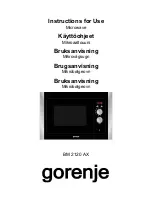
R-8000G
11
CAUTION: BEFORE REPLACING A BLOWN MONITOR FUSE
TEST THE DOOR SENSING SWITCH, PRIMARY
INTERLOCK RELAY, SECONDARY INTERLOCK
SWITCH AND MONITOR SWITCH FOR PROPER
OPERATION. (REFER TO CHAPTER “TEST PRO-
CEDURE”).
NOTE: MONITOR FUSE AND MONITOR SWITCH ARE
REPLACED AS AN ASSEMBLY.
3RD. LATCH SWITCH
The 3rd. latch switch is mounted on the upper position of the latch
hook right. When the oven door is opened, the switch interrupt the
circuit to the top and side heating elements.
THERMISTOR
The thermistor is a negative temperature coefficient type. The
temperature in the oven cavity is detected through the resistance
of the thermistor, and then the control unit causes the heater relay
to operate, thus the current to the heating elements is turned ON/
OFF. If the convection cooking or some cooking modes which use
the top / side heating elements is started and the oven temperature
does not rise above 100˚F (37.8˚C), the control unit will stop the
oven after 10 minutes. In this case, the thermistor may be opened.
MAGNETRON TEMPERATURE FUSE.
The temperature fuse located on the waveguide flange is designed
to prevent damage to the magnetron if an over heated condition
develops in the magnetron due to cooling fan failure, obstructed air
guide, dirty or blocked air intake, etc.
Under normal operation, the temperature fuse remains closed.
However, when abnormally high temperatures are reached within
the magnetron, the temperature fuse will open at 302˚F(150˚C)
causing the oven to shut down.
TOP HEATER THERMAL CUT-OUT
The thermal cut-out located on the thermal cover upper is designed
to prevent damage to the top heating element unit if an over heated
condition develops in the top heating element unit due to convec-
tion fan failure, thermistor failure, obstructed air ducts, dirty or
blocked air intake, etc.
Under normal operation, the thermal cut-out remains closed.
However, when abnormally high temperature are reached within
the top heating element unit, the thermal cut-out will open at 338˚F
(170˚C) causing the oven to shut down. When the thermal cut-out
has cooled, the thermal cut-out closes at 311˚F(155˚C).
SIDE HEATER THERMAL CUT-OUT
The thermal cut-out located on the thermal cover left is designed
to prevent damage to the side heating element unit if an over
heated condition develops in the side heating element unit due to
convection fan failure, thermistor failure, obstructed air ducts, dirty
or blocked air intake, etc.
Under normal operation, the thermal cut-out remains closed.
However, when abnormally high temperature are reached within
the side heating element unit, the thermal cut-out will open at 302˚F
(150˚C) causing the oven to shut down. When the thermal cut-out
has cooled, the thermal cut-out closes at 266˚F (130˚C).
TOP HEATING ELEMENT
The top heating element is located at the top of the oven cavity. It
is intended to heat air driven by the convection fan.
DOOR OPEN MECHANISM
The door is opened by pulling the door handle down and forward,
referring to the figure D-1. When the door handle is pulled down,
the latch heads are moved upward. And then when the door handle
is pulled forward, the latch heads are released from the latch hooks
right and left. Now, the door will open.
Figure D-1. Door Open Mechanism
DOOR SENSING AND SECONDARY INTERLOCK
SWITCHES
The door sensing switch in the primary interlock system is mounted
in the lower position on the latch hook right, the secondary interlock
switch is mounted in the lower position on the latch hook left. They
are activated by the latch heads on the door. When the door is
opened, the switches interrupt the circuit to all components except
for the oven lamp. A cook cycle cannot take place until the door is
firmly closed thereby activating both interlock switches. The primary
interlock system consists of the door sensing switch and primary
interlock relay located on the control circuit board.
MONITOR SWITCH
The monitor switch is mounted on the upper position of latch hook
left. It is activated (the contacts opened) by the left latch head while
the door is closed. The switch is intended to render the oven
inoperative by means of blowing the monitor fuse when the contacts
of the primary interlock relay and secondary interlock switch fail to
open when the door is opened.
Functions:
1. When the door is opened, the monitor switch contact close (to
the ON condition) due to their being normally closed. At this
time the door sensing and secondary interlock switches are in
the OFF condition (contacts open) due to their being normally
open contact switches.
2. As the door goes to a closed position, the monitor switch
contacts are first opened and then the door sensing switch and
the secondary interlock switch contacts close. (On opening the
door, each of these switches operate inversely.)
3. If the door is opened, and the primary interlock relay and
secondary interlock switch contacts fail to open, the monitor
fuse blows simultaneously with closing of the monitor switch
contacts.
DESCRIPTION AND FUNCTION OF COMPONENTS
Monitor switch
Latch hook left
3rd. latch
switch
Latch
head
Secondary
interlock switch
Door
sensing switch
Latch hook right
Latch
head














































